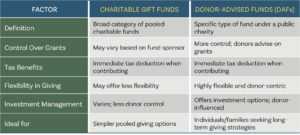
If you’re like our team at Carlson Investments, you have causes close to your heart—and you’re likely seeking regular ways to support these nonprofits with your time, money, and resources. There are many ways to donate to charity depending on your preferences, resources, and the organizations you care about. And there may even be some you haven’t considered!
Read on for nine popular ways both individuals and organizations can give back, plus a breakdown of charitable gift funds and donor-advised funds.
9 POPULAR GIVING METHODS
1. Monetary Donations
Monetary donations may be the first thing that comes to mind when we think of charitable contributions, which you can determine based on your budget and the organization’s needs. This includes:
- One-time Donations: Give a specific amount of money directly to a nonprofit.
- Recurring Donations: Set up monthly or annual contributions to support ongoing programs.
- Payroll Giving: Deduct a portion of your salary to donate regularly. Good for budgeting purposes.
- Matching Gifts: Some employers match employee donations, doubling your contribution.
- Qualified Charitable Distributions: You may be able to directly transfer money from an eligible IRA to a qualified 501(c)(3) charity.
Is there a nonprofit your employer already supports or one meaningful to you and aligns with your company’s mission? Talk to your employer about setting up payroll giving and a possible matching gift.
2. Donating Goods
Many charities need specific items—in fact, some may even prefer these goods to help them fulfill their missions. If you have things you no longer use or can purchase and donate items, consider contributing:
- Clothing: Donate gently used clothing to thrift stores, shelters, or other nonprofits providing clothing to those in need.
- Food: Give non-perishable food items to food banks or soup kitchens.
- Toys & Books: Provide toys or books to children’s charities, libraries, or hospitals.
- Furniture & Electronics: Donate usable furniture or electronics to organizations like Habitat for Humanity.

3. Volunteering
Of course, nonprofits often need hands-on support, too! Local shelters, food banks, or fundraisers/events typically have volunteer opportunities that allow you to make an impact with your time and skills.
Do you have a specialty? Professional services like legal advice, graphic design, or tutoring can also be invaluable to charities—and offer a fulfilling way to use your expertise.
Volunteering is also a great team-building exercise! Carlson Investments loves giving back as a team. We’ve partnered with the Boys & Girls Club of Greater Manchester, Easterseals New Hampshire, Circle Program, Animal Rescue League of New Hampshire, and New Hampshire Food Bank. These experiences allowed us to see our impact, work with wonderful people, and share fun-filled moments.
4. Organizing Fundraisers
If you want to make a big difference for a charity close to your heart, consider organizing a fundraiser. Nonprofits often offer ideas and resources for hosting events such as bake sales, charity runs, or auctions. You can also use online platforms to organize crowdfunding campaigns, so people near and far can easily contribute.

5. Workplace Campaigns
You can also get your team on board with a workplace charity drive or fundraising event. For example, set up weekly food donations or a friendly athletic competition.
Another option is supporting causes through corporate social responsibility programs, such as sustainability initiatives.
6. Donating Stocks or Investments
Have you built a strong portfolio and wish to use some of it for good? You can donate stocks, bonds, or mutual funds, which can provide tax advantages for both you and the charity.
7. Legacy Giving
Consider including a charity in your will or estate plan. You can even set up a charitable trust or foundation to leave a lasting impact.
8. Sponsorships
Sponsorships offer a great way to see your direct impact by sponsoring a child, family, or specific project through charities like World Vision or Save the Children.
9. In-Kind Donations
If your business would like to ease the financial burden on nonprofits you care about, consider providing specialized resources or services. This could include offering free venue spaces, donating medical supplies, or catering events.
A Closer Look at Charitable Gift Funds & Donor-Advised Funds
There are two more ways for both individuals and organizations to manage charitable giving on a larger scale: charitable gift funds and donor-advised funds (DAFs). Let’s look at how they work, their benefits, and their considerations.

10. Charitable Gift Funds
A charitable gift fund is a general term for pooled funds or accounts managed by a public charity to which donors contribute for philanthropic purposes.
Donors contribute cash, stocks, or other assets and often receive immediate tax benefits. The public charity or fund sponsor manages the investments, and the money is eventually distributed to qualified charities. Examples of charitable gift funds include community foundations, religious organizations, or other public charities.
It’s important to note that:
- Charitable gift funds are usually less customizable than DAFs
- Control over grant-making decisions might be more limited depending on the structure
- Fees and investment strategies vary widely, and donors may have less influence over how funds are invested
11. Donor-Advised Funds (DAFs)
A DAF is a charitable giving account set up under a public charity. It allows donors to recommend grants to qualified nonprofits over time.
Donors contribute assets such as cash or stocks to the DAF and receive an immediate tax deduction for the contribution. The funds are invested and can grow tax-free. Donors then “advise” the sponsoring organization on when and where to make grants, though the sponsor makes the final decision. Example sponsors include Fidelity Charitable and DAFgiving360™, the DAFs of Fidelity Investments and Charles Schwab, respectively.
DAFs offer benefits such as:
- Significant control over grant recommendations, timing, and recipient organizations
- Typically lower administrative fees than setting up a private foundation, with varied investment options
Below is a quick comparison of charitable gift funds and DAFs.

Building a Future of Giving Back
If you’re considering a charitable gift fund or DAF, understanding your philanthropic goals and how much control you want over your contributions can help you determine the best fit. Carlson Investments will gladly guide you through the process, whether you’re debating between these funds, legacy giving, or another way to use your wealth for good. Contact us today to learn more about setting up a fund, tax implications, or specific scenarios!
Carlson Investments does not provide tax, legal, or accounting advice. This content has been written for informational purposes only. Always consult your individual tax, legal, or financial professionals for advice tailored to your situation
Let's Talk
Finding a better way doesn’t start with you learning about investment strategy. It starts with us learning about you.
Let’s get started.
Contact Us